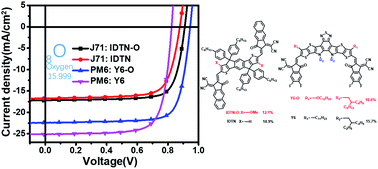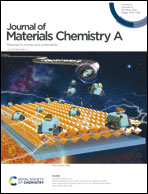Alkoxy substitution on IDT-Series and Y-Series non-fullerene acceptors yielding highly efficient organic solar cells†
Abstract
In this work, we attempt to figure out alkoxy-substitution effects on two kinds of well-known non-fullerene acceptors (NFAs), IDT-series and Y-series acceptors, by placing alkoxy side chains on the β-positions of the outer thiophene units. The resulting molecules, named IDTN-O and Y6-O, exhibit different properties compared to the original acceptors named IDTN and Y6. The HOMO and LUMO levels of IDTN-O are slightly upshifted at the same time, which causes a slightly higher open-circuit voltage (Voc) without sacrificing the short-circuit current density (Jsc) of the devices. J71:IDTN-O blend films can also achieve a better blend morphology due to the conformational locking effect and higher dipole moment induced by the alkoxy groups, which helps achieve a higher fill factor (FF). In addition, Y6-O exhibits significantly upshifted LUMO levels compared to Y6, leading to a high Voc of 0.95 V. PM6:Y6-O blend films can also maintain an optimal blend morphology through side-chain engineering, which leads to an excellent FF of 78.0%. As a result of alkoxy substitution, both IDTN-O and Y6-O-based devices can achieve better performances of 12.1% and 16.6% than IDTN and Y6-based devices (10.9% and 15.7%), which indicates that this is an effective method to optimize these two types of NFAs.



 Please wait while we load your content...
Please wait while we load your content...